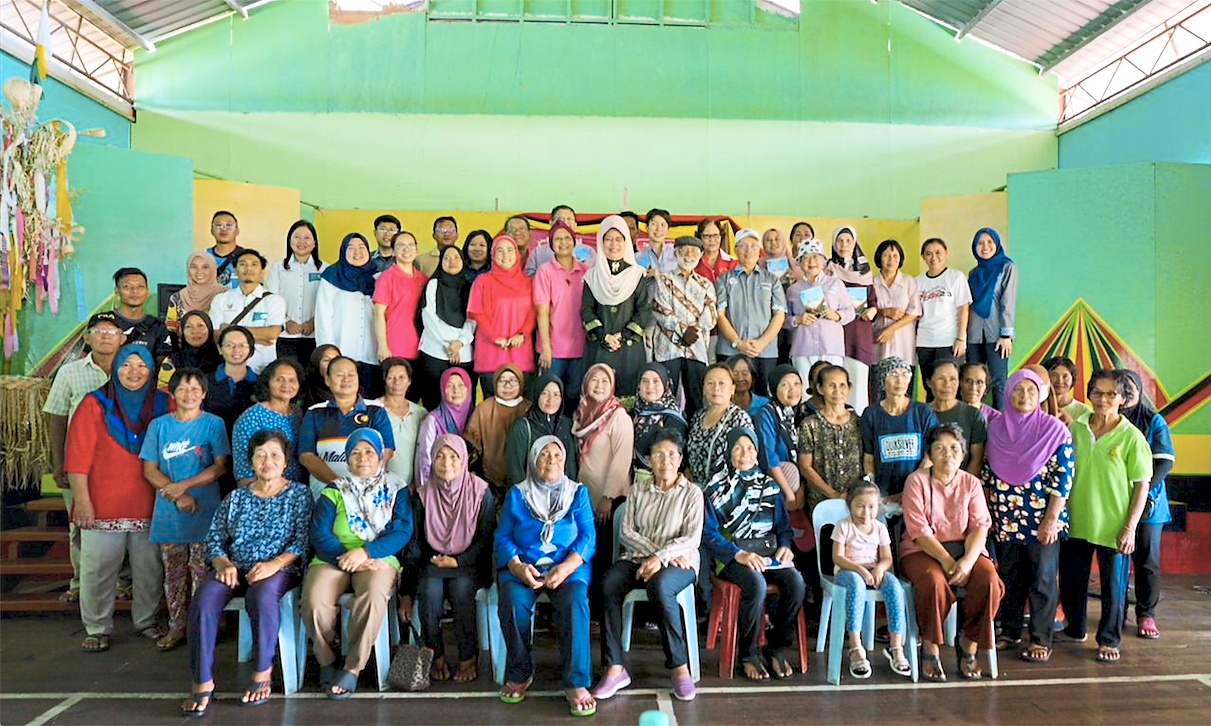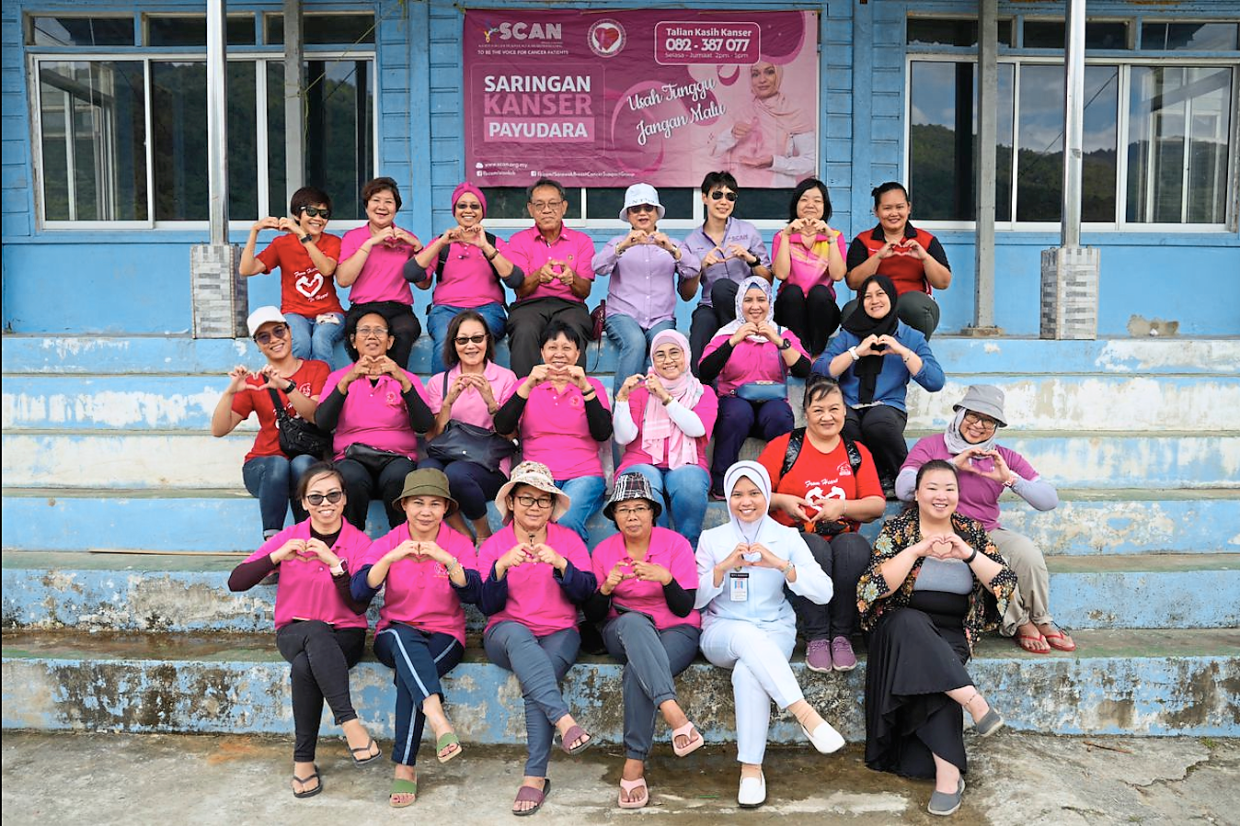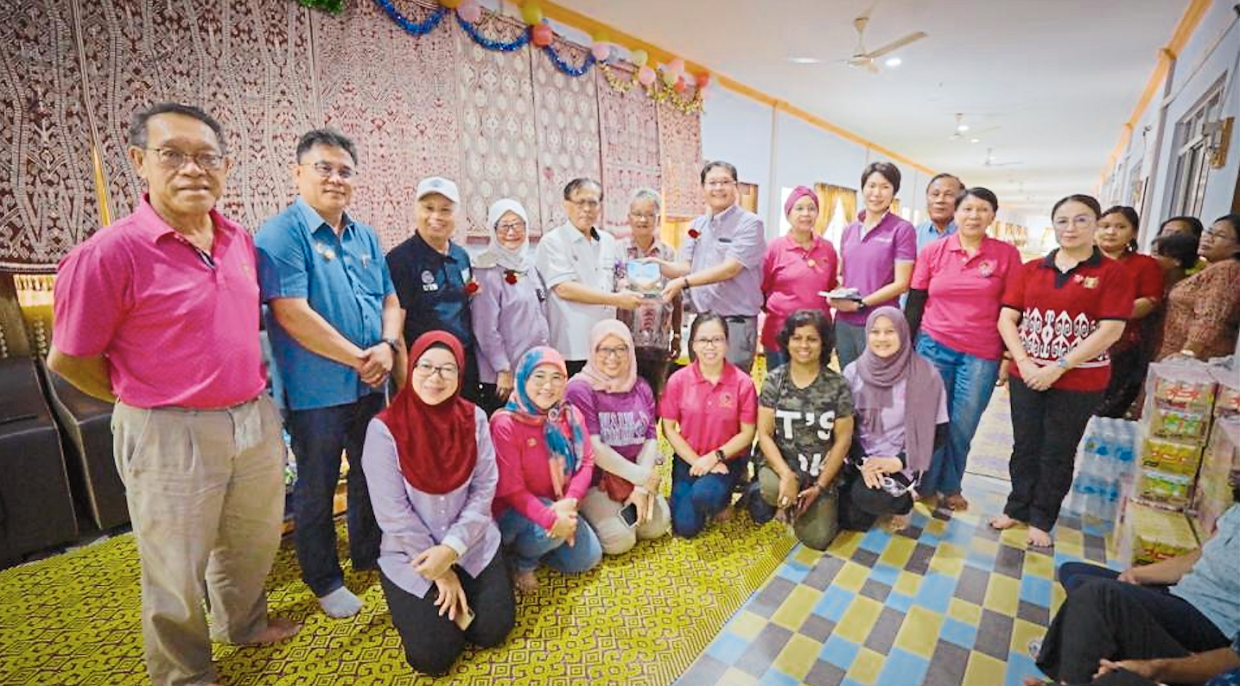Sarawak Women, Childhood and Community Wellbeing Development Minister Datuk Seri Fatimah Abdullah.at the outreach programme. Photo: SCAN
The lack of awareness about breast cancer symptoms as well as breast self examinations, and limited mammogram services are among the main reasons why marginalised communities face a greater cancer risk.
A cancer patient’s socioeconomic status and geographical location – known as the “equity gap” – has been said to greatly determine their chances of surviving cancer, says Dr Melissa Lim, a clinical lecturer at Universiti Malaysia Sarawak, and member of the Society for Cancer Advocacy and Awareness Kuching (SCAN) and the Sarawak Breast Cancer Support Group (SBCSG).
It is with this in mind that Closing The Care Gap, a short docu-film was recently launched by SCAN and SBCSG.
The docu-film sheds light on the harsh realities faced by marginalised communities, particularly those in low-income areas.
“It reveals the impact of limited access to healthcare that these marginalised communities in low-income areas are facing,” says Dr Lim.
“And it unveils the untold stories of breast cancer survivors and the challenges faced by individuals in rural Sarawak where healthcare resources are often scarce; lack of awareness, finances, insurance, and transport; communication difficulties; as well as fear of the unknown,” she says.
In 2022, through a breast cancer grant from the Union for International Cancer Control (UICC), Dr Lim, who is also a cancer researcher and patient advocate, embarked on a project titled “Beyond breast cancer awareness in rural Sarawak, Borneo – a documentary of outreach programmes”.
This brought about the collaboration between SCAN, SBCSG and the Health Ministry to carry out outreach programmes to four villages in rural Sarawak: Rantau Panjang – Batu Kawah, Kampung Buduk Nur – Ba-kelalan, Sungai Kut – Dalat, and Rumah Untang – Kapit.
A total of 1,954 women were screened and 126 (6.4%) were found to have breast abnormalities such as lumps. The majority of the women were Bidayuh (26.1%), Chinese (21.3%), and Malay (14.3%). Only 13.8% had mammograms done before and 8.2% had a family history of breast cancer.
Addressing the gaps
According to Dr Lim, the documentary emphasises the urgency of addressing the equity gap in healthcare, and advocates for equal opportunities to healthcare as a fundamental human right.
“It is a call to action, encouraging collective efforts to bridge the care gap for individuals facing cancer in underserved communities,” she adds.
Hindrances to breast cancer screening include lack of mammogram services (there are only four facilities that offer mammograms throughout Sarawak), logistics issues, lack of awareness and cultural barriers.
Most patients from rural areas have to travel very far to get to the treatment they need, when diagnosed with cancer. Chemotherapy can only be accessed in major hospitals in Sibu, Miri and Kuching while radiotherapy can only be accessed in Kuching. High travelling costs hinder these patients from getting a timely diagnosis and treatment. Cultural barriers are also one of the issues as many belief in traditional medicines to treat their illness.
The docu-film highlights that, as one of the largest states in Malaysia and one with the most challenging terrain, Sarawak’s cancer patients have to deal with limited access to healthcare facilities and specialists.
SCAN advisor and breast cancer survivor Datin Dayang Mariani says that screening is not available in most rural communities so there’s a need to increase facilities in these areas.
“To ease congestion, it would be good if private hospitals can do CSR and outreach work with us,” she says.
SBCSG medical advisor Datuk Zulkifli Jantan highlights that “screening services provided by private and public health facilities aren’t accessible to everyone. Also, not everyone is aware of the need for screening or can afford it”.
SCAN vice president and breast cancer survivor Dr Fitri Suraya adds that there are many who are still unaware about cancer, and also some who won’t talk about nor address it even when they’re aware of it.
“It takes mountains to move people to voluntarily go for screening at medical facilities. To resolve this issue, we have to organise health screenings within the communities themselves to encourage the women to step forward and screen,” she says.
SCAN founding president and breast cancer survivor Sew Boon Lui believes more awareness education is needed in both rural and urban areas.
“It’s important to make cancer, especially breast cancer, part of the health education syllabus, from upper primary or lower secondary school. Organising health talks in schools during family day events is also necessary.”
Meanwhile, Sarawak Women, Childhood and Community Well-being Development Minister and SCAN Patron Datuk Seri Fatimah Abdullah says that the docu-film highlights how something as basic as transportation poses a huge challenge for cancer patients in these communities because there isn’t any public transport they can rely on. Instead, they have to find someone or pay people to bring them to the hospital.
Some villagers are forced to travel either in a 19-seater twin otter (bush aircraft) or a four-wheel drive vehicle over logging roads.
Dr Lianne Hendricks from the Lawas District Health Office also highlights that poor road conditions also hamper accessibility of these rural communities to the towns.
“Often the drive takes three to four hours for the cancer patient to get to the hospital.”
The docu-film reveals that many of the patients who live in rural parts of Sarawak are farmers and fishermen, and they can’t afford the treatment costs.
Furthermore, the places are not only remote but each community also has their own dialect so there are language barriers, says Sarawak General Hospital Breast and Endocrine Surgeon, and SBCSG member Dr Sharifah Ashrina Wan Ali.
“Because there are over 30 ethnic groups in Sarawak, each with their own native dialect, we need to speak to them in their own language in order to communicate with them and educate them about cancer,” says Dr Lim.
Reaching out
About 40% of breast cancer cases in these communities are diagnosed at stage three and four, because of all these issues, says Dr Lim.
There are only four public mammogram screening facilities in Sarawak and many patients are diagnosed at advanced stages with fungating breast wounds due to lack of awareness and obstacles to accessing care.
This is why SCAN and SBCSG have joined hands to make a difference to spearhead outreach programmes that will reach the remote and underserved communities in Sarawak.
The outreach programmes aim to empower these communities with the relevant knowledge, and provide them with the tools to detect cancer early, and improve their health, she says.
She adds that such outreach programmes will “go to where the people are”, in their own communities and villages. This will help solve their issues with finding transport to the cities for screening and treatment.
“In these remote, rural areas, it’s not just a medical check-up or cancer screening for them, but it’s a lifeline to a healthier future.”
Dr Lim says that another solution is patient navigation, which should be widely integrated as part of the healthcare system.
"A patient navigation service will guide patients through the health service as well as the address the barriers to them getting proper healthcare.
“Patient navigation is a process where a person within the community engages with a patient. The navigators assist them in scheduling appointments, explaining treatment options, and addressing issues they may face such as transportation or finances,” she says, adding that it will reduce their emotional burden.
Some examples of successful patient navigation programmes include initiatives by the American Cancer Society, Cancer Research Malaysia, The National Cancer Society of Malaysia, and The Philippines’ ICanServe Foundation.
Cancer is not a death sentence. There are many survivors and carers who live full lives after a diagnosis. Hence, patients in these communities should be given what they need so that they too can have a chance to enjoy similar successful outcomes as well, she concludes.













